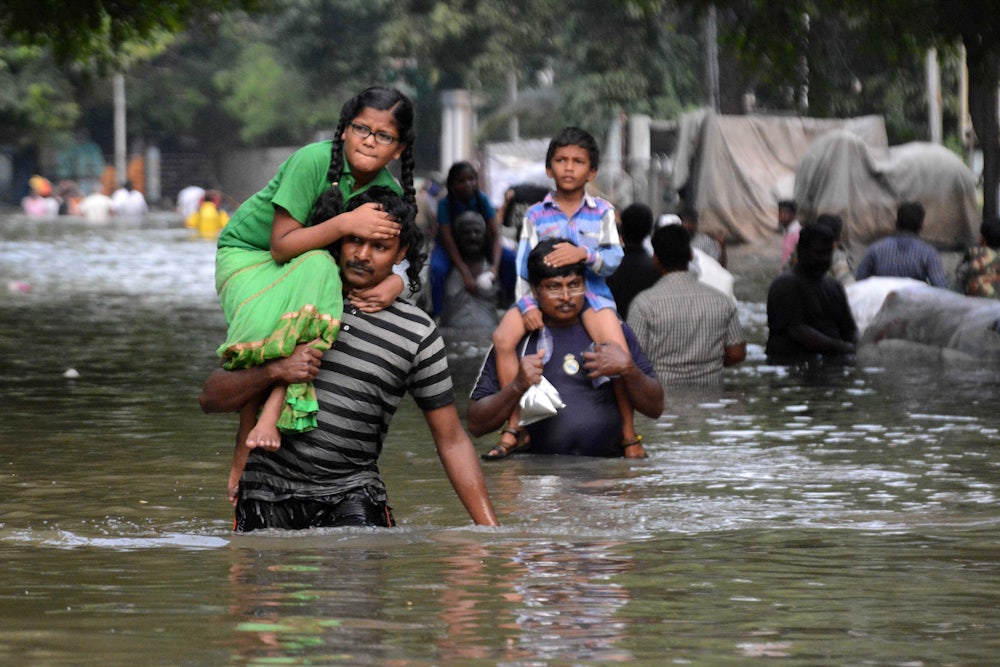In 2015, the winter monsoon season brought torrential rains to Chennai, in southern India. Unprecedented floods followed, and some parts of the city of six million residents experienced floodwaters as high as eight feet. About 130,000 people were evacuated to relief shelters; 347 people died, as well as 3,889 cattle meant to provide sustenance.
The government warning came too late for many Chennai residents. The heaviest recorded rains in more than a century had overwhelmed the dam. Photographer and artist Anjali Ponni Rajkumar was at home with her family in the affluent Purusawalkam neighborhood when the disaster began. She left immediately to help other residents.
“It took everybody by surprise,” said 42-year-old Rajkumar, who runs her grandfather’s photo emporium and specializes in wedding photography. “The warning didn’t prepare us by any means. First, officials didn’t anticipate the extent of these rains and were forced to open the floodgates of some of the city’s 30 waterways. One close to me overflooded, and some of the poor residents along the riverbanks swam to safety. Slum dwellers don’t live in houses but in huts, so they couldn’t seek safety anywhere else.”
Some affluent areas in the city were affected, too.
“There, people did much better because they sought safety on higher floors or on the rooftops on their houses, and rescue boats were able to pick them up, and they checked into hotels,” Rajkumar said.
She volunteered at the nearby Egmore Children’s Hospital, delivering blankets and clean clothes to survivors. “I had to walk in some water,” she said. “The hospital didn’t flood, even though it was surrounded by floodwaters. I also picked up emergency supplies for the hospital that were delivered to other parts of the town. I volunteered at the hospital for about one week. In the meantime, the slum dwellers were evacuated to nearby colleges.”
Devastated communities didn’t always welcome the help. “There was a lot of anger,” Rajkumar said. “My friends brought pizzas for the dwellers, and they said: ‘What is this? We don’t want any pizzas.’ It got rowdy, and they threw the pizzas back to them. There was and still is a lot of resentment because of the division of people into those who have and those who don’t.”
Rajkumar believes the reason for the divide is governmental corruption. “The government doesn’t really look after our people,” she said. “They allocate money to many things, but it doesn’t get delivered. It’s more about themselves: ‘How can I fill my pockets?’”
Rajkumar dates her own realization of Chennai’s stark inequalities to 2008, when she returned after earning a master’s degree in biotechnology at the University of Pennsylvania and began noticing the scale of poverty in her hometown and only a few miles from her house.
“During the floods I felt that, for the first time in my life, residents of Chennai really came together to help,” Rajkumar said. “It didn’t matter what walk of life you came from. Drinking water was sparse, so people delivered water for the survivors. Everybody did what they could.”
Floods aren’t the only time residents face shortages of potable water: Rainy and drier seasons fluctuate almost yearly. Rajkumar’s family is fortunate to be able to buy a truckload of water and store it in three water tanks at home. During water shortages, poor residents stand in line in the streets every day to buy one bucket of clean water.
“I first got involved with the children’s hospital as a volunteer arts teacher for children with cancer,” Rajkumar said. “Soon, I found out that the hospital didn’t have enough water for cooking or washing or cleaning. I organized a system so that an adequate amount of water is regularly delivered to the hospital. In general, our government does such a bad job storing water.”
Everyday life is enough of a challenge for many residents that changing weather patterns don’t appear in regular conversation. “Or they might, just after the floods,” said Rajkumar. “But after six months, everybody goes back to their own worlds. I don’t think even schools educate kids enough on environmental issues.”
Rajkumar continues volunteering and teaches her 5-year-old son to recycle. “If we throw plastics away, the cows eat them,” she tells him. It’s one small bit of sustainability that she can control. “India has plenty of smart people and resources. We could be a very self-sufficient nation and grow in so many fields, if people in the government would just allow it,” she said. “Even the floods could have been managed, if the government didn’t screw up. So far, I do what I can to help residents and animals of the city. I feel I can contribute in my own way. That’s my future.”

Voices From the Future is a series from the front lines of climate change and extreme weather in collaboration with the Julie Ann Wrigley Global Futures Laboratory at Arizona State University.
